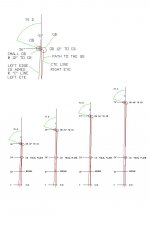It's like a riddle.
While standing, I can see the CTE line with my dominant right eye. In order to see the secondary aim line ,that will require that I move my position to a new location to do so. If I use my dominant eye to see this new line, my dominant eye cannot be aligned with the CTE line - physically not possible.
I can leave my right eye focused on the CTE line and bring my left eye into the picture to see the left edge of the CB and move my position until that edge is now aimed at the fractions on the OB (for cuts to the left) but my right eye will not be able to remain on the CTE line.
If I try this for cuts to the right I think that I should use my left eye on the CTE line and bring my right eye into the picture to see the right edge of the CB in order to aim it at the fractions on the OB.
I accept the/your logic that only one eye can also work, but the secondary aim line will pull the one eye away from the original CTE line. Using one eye will work for both cuts to the left and cuts to the right, but again my eye will be drawn away from the CTE line.
So can I conclude that as Hal said, that the CTE line is to get the body into a good starting position to pivot right or left? From the CTE line and position, I can then move away from that line to focus on the secondary aim line and drop down on the shot with the correct stance and effect the 1/2 tip offset to the side of the center of the CB and then pivot back to the center of the CB?
This is like what I call edge of the CB aiming at fractions, but with the 1/2 tip offset and pivot.
If this is acceptable, and applying the moving of the bridge location back from the CB to compensate for the greater separations between the CB and OB, then this can be diagramed and demonstrate that this form of CTE aiming can be geometrically correct.
If not...not.
Thanks for your help.
While standing, I can see the CTE line with my dominant right eye. In order to see the secondary aim line ,that will require that I move my position to a new location to do so. If I use my dominant eye to see this new line, my dominant eye cannot be aligned with the CTE line - physically not possible.
I can leave my right eye focused on the CTE line and bring my left eye into the picture to see the left edge of the CB and move my position until that edge is now aimed at the fractions on the OB (for cuts to the left) but my right eye will not be able to remain on the CTE line.
If I try this for cuts to the right I think that I should use my left eye on the CTE line and bring my right eye into the picture to see the right edge of the CB in order to aim it at the fractions on the OB.
I accept the/your logic that only one eye can also work, but the secondary aim line will pull the one eye away from the original CTE line. Using one eye will work for both cuts to the left and cuts to the right, but again my eye will be drawn away from the CTE line.
So can I conclude that as Hal said, that the CTE line is to get the body into a good starting position to pivot right or left? From the CTE line and position, I can then move away from that line to focus on the secondary aim line and drop down on the shot with the correct stance and effect the 1/2 tip offset to the side of the center of the CB and then pivot back to the center of the CB?
This is like what I call edge of the CB aiming at fractions, but with the 1/2 tip offset and pivot.
If this is acceptable, and applying the moving of the bridge location back from the CB to compensate for the greater separations between the CB and OB, then this can be diagramed and demonstrate that this form of CTE aiming can be geometrically correct.
If not...not.
Thanks for your help.
Last edited:
